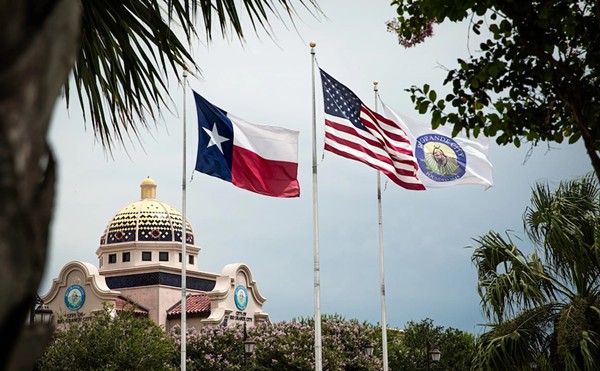Santos's work weaves through the cultural minefield
In his 1943 treatise on existentialism, Being and Nothingness, Jean Paul Sartre uses vignettes to explain the individual’s estrangement from the world. The great irony of existentialist writing, he reveals, is the presentation of a protagonist absorbed with being alone even as he is surrounded by multitudes.This preoccupation with existence and nonexistence, life and death, being and nothingness, also animates John Phillip Santos’s polymorphous memoir, Places Left Unfinished at the Time of Creation, which was chosen to inaugurate the San Antonio Library Foundation’s One Book/One San Antonio program in June.
As a finalist for the prestigious National Book Award in 1999, Places received wide-ranging press coverage — including glowing reviews in The New York Times, Los Angeles Times, Chicago Tribune, Washington Post, and the Village Voice. In the three months since the anointing of Places by a panel of San Antonio media, business, and education leaders, Santos has enjoyed what most writers never experience: the rebirth of a book from the surplus bargain bins of internet booksellers.
The second printing has been met by a resurgence in sales. The San Antonio Library alone purchased 788 copies! According to San Pedro Library Branch Director Jaqueline Caverly, the text with the next-highest number of books in their circulation is the Harry Potter series, with 219 copies.
| “These ancestors, living and dead, have asked me the questions they were once asked ... What messages and markings of the ancient past do we carry in these handed-down bodies we live in today?” — John Phillip Santos |
This explosion in regional sales has been accompanied by a blitzkrieg of media appearances, including interviews on National Public Radio, Texas Public Radio, Latino USA, and an interview on Ilan Stavans’s Latino talk show, La Plaza, which is produced by Boston Public Television. Texas Public Radio has even subsidized the production of MP3 files of Santos reading from his book, available free online. The August 25 Texas Public Radio show hosted by Yvette Benavides that included Sandra Cisneros, Michael Soto, Naomi Shihab-Nye, and Cary Clack was, for lack of a better term, a veritable love fest.
Obviously moved by the lush writing and pastoral excursions through old San Antonio, South Texas, and Northern Mexican towns of Santos’s ancestors, panelists repeated Santos’s oft-quoted description of Places as “my love story for San Antonio.”
Nye, a former poetry teacher of Santos, still remembers an early poem the author wrote when he was 16, and lauds her former pupil’s exquisite faculties as an adult author, especially the magical realism he seamlessly weaves into his family saga. She adds that Santos “has a lyrical gift that can transport us to any place in the past, and the title invites the reader to continue finishing the story of San Antonio.”
Cisneros praises Places as a “book that can help us understand communities still in conflict. It is a conflict that happens with race, and is very unspoken, very subtle, but very real.” For her, Santos’s book “is about remembering and forgetting, and about stories that show the expense of what is forgotten.”
“This book,” Cisneros emphasizes, “connects us to common mythology, events in history that are painful, but that gave birth to who and what we are today. It is not about dividing communities, but uniting them.”
Impressed by the thick baroque prose and vivid visual descriptions, Clack calls Places a “prose poem.”
It is safe to say that Santos, quite simply, has taken the Alamo City by storm.
But a harsh and frightening reality underlies the platitudes: Santos’s inaugural tome arose from the most dreaded of events — a January 1939 newspaper account of a “well dressed body floating in the San Antonio River.” The unnamed body just happened to be John Phillip Santos’s paternal grandfather.
Places, Santos notes in a recent interview at Ruta Maya Coffee House — which sits on the same river where his grandfather was either murdered or committed suicide — “began as an investigative attempt to find out what really happened and what it all meant to me as a family member, as a Mexican American, as a human being.” He adds, “one can’t help but try to fathom the meaning of existence when your reason for being, the death of an ancestor whose own existence was required for you to come into existence, ceases to exist except as a story that is told only in hushed tones.”
In the introductory section of Places, subtitled “Tierra de Viejitas/Land of Little Old Ladies,” Santos links his search to a broader human quest:
“These ancestors, living and dead, have asked me the questions they were once asked: Where did our forebears come from and what have we amounted to in this world? Where have we come to in the span of all time, and where are we headed, like an arrow shot long ago into infinite empty space? What messages and markings of the ancient past do we carry in these handed-down bodies we live in today?”
That this age-old existentialist inquiry has touched a universal nerve in San Antonio is evidenced by the selection of Places as a common text in such diverse student bodies as UTSA’s Learning Communities Initiative, which serves several hundred primarily minority students, as well as Trinity University’s overwhelmingly white and middle-class incoming freshman class, for which Places was recommended summer reading.
But what does it mean that a hybrid, detective-memoir-travel narrative about a middle-class Mexican American family has become the talk of the town? What is the message in the book, an impatient student might ask, and what is the message of the book’s consumption as the belles lettres de jour?
Where you from, ese?!
In sectors of the Latino community gripped by gang warfare, the way one answers this query can mean the difference between life and death. For Santos, the way one writes about birthplace, and the spaces inhabited postpartum, is equally as dangerous. In the politicized world of publishing and literary studies, every Latino author must negotiate a minefield: Do you translate the Spanish to increase your book’s marketability? Reveal a family tragedy that might be misread as “evidence” of Latino pathology? How much do you pander to market forces that expect cliché gangster spectacles or pathos-laden stories of poverty?
Santos inevitably disappoints as many people as he pleases. Some readers, like Rachel Walsh who attended the August 25 reading at the San Pedro Library, complained that the book was difficult to read because of its esoteric diction. Others have condescendingly praised it for using formal, “correct” Spanish, as opposed to the underclass Chicano “Spanglish” known as Caló that few outside the Chicano community can understand.
Santos is genuinely interested in both critiques, while safely anchoring himself in the mantra of creative writing workshops: “I write what I know.” What Santos knows is a world that is at once universal yet unique to his Mexican-American middle-class background. Herein lies one crucial point of contention that is being debated in literature seminars and academic conferences: genus.
The title of Santos’s text calls attention to itself by its sacrilegious yet solipsistic focus on stories, storytelling, and the inherent schism between naming or identifying and the essence of the thing named. Earlier working titles dating from 1990 were even more esoteric: “Immaterial Empires: Journeys into the Chicano Soul,” “An Impossible Memoir,” and the overtly existentialist “a Memoir Without a Subject.” The subtitle ultimately selected was “A Memoir,” which was the publisher’s marketing decision. This tag enabled the book to be shelved under two categories — “Autobiography” and “Latin American Studies” — but it had profound ideological implications.
Since Benjamin Franklin’s seminal 1771 Autobiography, American autobiographies have been distinguished for presenting a “common-born” protagonist who confronts the world as an individual and ultimately triumphs to become a more-affluent individual. (African-American slave narratives and contemporary Black autobiographies are notable exceptions that provide more realistic explorations of the social contradictions that prevent some citizens from achieving success, and evoke a more communal model of identity.)
Memoir, on the other hand, can be understood as a partial autobiography written around an event or experience such as an illness or trauma. Many memoirs lean toward empathetic meditations on human suffering, though American memoirs are often narcissistic. Santos muddles matters more by subtitling Part I “Testimonio,” which carries a profoundly different resonance in Latin-American Studies than its English translation would suggest. Testimonio is not just a variation on the deprivation-to-salvation “testimony” one hears between Christian televangelist donation appeals. Scholars like John Beverly note that while modern testimonio has its roots in early Christian works by St. Augustine as well as travel narratives by Hernan Cortez, it is more akin to Che Guevara’s 1959 Passages of the Revolutionary War in Cuba.
Since Guevara’s account of the transformation of a bourgeois medical student into a member of a revolutionary cadre in the struggle against greedy capitalists, the genre has exploded throughout the Americas. Testimonios reached an apex during the 1970s and 1980s with works by various “subordinate” subjects who used an otherwise conservative literary mode — the story of a life — to articulate a completely different type of collective “I.”
Notable testimonios include Omar Cabezas’s 1986 Fire From the Mountain, about the transformation of Nicaraguan college students into revolutionaries, and Nobel Prize winner Rigoberta Menchú’s 1982 My Name is Rigoberta Menchú. Chicana authors have led the testimonio movement in the U.S., with Cherrie Moraga’s 1983 Loving in the War Years serving as a benchmark in the genre’s meditations on aesthetics and politics, identity and power.
Santos’s Places is neither autobiography, memoir, nor testimonio, but a hybrid of all, as well as travelogue and anthropological field notes from his work as a documentary film producer that took him to places as far away as Khartoum, Sudan. Even before his inadvertent rehearsal of the ahistorical party line that “all of the revolutions had failed, been infiltrated, assassinated, corrupted, or simply became vengeful and vindictive,” Santos’s otherwise insightful book fails to function as the outsider testimonio precisely because of its class politics.
An alumnus of Churchill High, Santos graduated Cum Laude from Notre Dame in 1979 with a major in philosophy and literature. He subsequently was selected as a Rhodes Scholar and studied English Literature at St. Catherine’s College at Oxford, followed by Ph.D. study at Yale, which he interrupted in 1983 to pursue a career in journalism. Santos worked as an arts-features writer for the San Antonio Express-News from 1983-84, and then as a documentary film producer for CBS and PBS. His last job before returning to San Antonio in 2004 was program officer in the Media, Arts, and Culture Division of the Ford Foundation, overseeing the distribution of $42 million in grants.
Throughout his studies and travels over several continents, Santos’s personal journal was a constant companion, as was poetry. Since the age of 14, Santos wrote verse preoccupied with family and, above all else, what human relationships reveal about the nature of existence. (Wings Press will publish his poetry collection, Songs Older Than Any Known Singer, in 2007.) Santos’s description of himself as a “dressed-up campesino” (“farmhand”) is a perfect metaphor, since Places includes several pastoral vignettes on family ranches in Mexico and outside San Antonio. The Santos family owned land, and a portion of a Spanish land grant remains in the family today.
Yet while Places explores the rise of a middle-class subject with an overbearingly Christian name — John Phillip Santos — this subject is indelibly marked by race. Santos still is a “Meskin” in local Texan bigotese. He takes the high ground, however, and addresses the issue of discrimination through his signature lyricism:
“Those were the days when the taco and the tamal were stigmatized in public, and Spanish was seldom heard on downtown streets. The old tíos had to speak English, often haltingly, to get along in the working world. Most of las Viejitas, staying in their homes, spoke only Spanish, or at least pretended not to speak English. When Uela spoke Spanish, her sentences moved in one steady arc, like a bow across a violin, and her words were delicately pronounced, so that you could hear every tinkle of an old chandelier.”
But lingering resentments are evident in Santos’s recollections of his high-school principal’s sabotage of his application to Harvard University. Santos got the last laugh by being named a Rhodes Scholar, but even this victory is tinged. Much continues to be made of Santos being the “first Mexican-American” Rhodes Scholar, stressing the “Mexican” as if people are still astonished that such a beast can be so intelligent as to receive the honor. Comparatively little has been made of the fact that Santos helped lift Notre Dame to a higher echelon in the academic rankings by becoming the institution’s first student of any race or creed to win one in nearly two decades!
Some Latino academics have expressed distaste for Places under the charge that it degenerates into a personal travel narrative and bourgeois success story that does not reflect Latino realities. Others read the piece as inscribed with tragedy that keeps it grounded and consummately universal. Indeed, amid the broad epic strokes, such as the conquest of Mexico — which involved genocide — there are many other deaths that go unnoticed in the world.
As noted in an Afterword, Santos’s father also was killed in an automobile accident one block from his home just five days after Places was finished. The elder Santos never got the chance to read the complete manuscript. Another death also haunts Santos, that of a childhood friend and intellectual soul mate who fell from the heights of sophomore valedictorian to dope dealer and murder statistic.
That Santos chose not to write about this tragedy is understandable and commendable; there already is enough pain in a book about remembering and forgetting deaths. The worst thing he could have done was exploit his friend’s tragedy as Ruben Navarrette did in A Darker Shade of Crimson (Bantam 1994), which sensationalized the story of Harvard classmate Jose Razo, who snapped and went on a crime spree after failing to fit into the rarefied world of elite universities. Yet, Santos lost an opportunity to levy a provocative class analysis of why every minority “success” story is accompanied by a plethora of stories about legions that were swallowed by the dangers of underclass existence.
But this has been done before by fellow Rhodes Scholar John Edgar Wideman, not to mention many Latino authors. Santos has another, equally important, mission.
The second coming of Santos
The best way to understand Santos-mania, and the value of his writing, is to attend a live reading. His baritone whisper and dramatic rendering of characters is as mesmerizing as a Spalding Gray monologue. But Santos is much more glamorous in his nouveau-Latino fashion that is a mix of East Village chic, New Mexico Shaman, and a little Penner’s thrown in for good measure. At the San Pedro Library reading, he wore a soothing sky-blue 70s-ish tunic, white pants, and black, ring-necked-python cowboy boots. His reading was accompanied by the flamenco guitar licks of Ray Tamez.
A Santos reading has the aura of a revival, which often is followed by audience testimonials about family histories. At one event, Santos was treated to a 1900s map that showed the original Spanish names of local streets. At another, he was given a vintage newspaper clipping about a great aunt mentioned in the book. The newspaper account noted that she had become the oldest “working woman” in San Antonio whom some patrons paid for a bit of local lore instead of sex! Santos quips that she was merely carrying on a family tradition: “Family members often take on professions that enable them to pursue their true calling in life — telling stories about San Antonio.”
Good writers are renowned for exceptional work in a given genre. Great writers are distinguished for creating their own genre, and Santos’s second book, as yet untitled, is also promising for its fusion of multiple genres and media. What can only be described as a Sci-fi Internetelenovela, this story involves a fantastical meeting between an amateur family genealogist — Santos — and his “ancestor from the future,” who inhabits cyberspace.
As an artist, Santos has always been ahead of the curve. While working for CBS in the 1990s, he pitched a documentary that would have explored the new Sudanese president’s relationship with a special guest — Osama bin Laden — but was rebuffed. He also produced groundbreaking documentaries on AIDS at a time when the nation’s leaders still feared uttering the acronym in public.
Santos’s current labor of love was first articulated in his Rhodes Scholarship essay: the creation of an institute to study the complex legacy of cultural mestizaje. This goal already has had incredible preliminary successes with a related San Antonio Museum of Art exhibit, roundtable, and lecture series this summer. With the support of UTSA, which provides Santos with office space, and collaborations with Trinity Professor Arturo Madrid, who has helped plan the concept and secure co-sponsorships, the project is on firm footing. Santos plans to base the institute in San Antonio because he says “this is where this conversation about mestizaje takes place on a daily basis, not in New York.” In pursuit of this life-long dream, Santos left a career and lucrative salary, but proclaims, “I have nothing, and everything: I am a working artist with an idea.”
Madrid concurs: “Like a number of other talented Tejanos that includes artists like Franco Mondini-Ruiz and Rolando Briseño, brothers Jose and Roberto Jimenez, and academics like Ricardo Romo, John Phillip Santos returned to bolster an artistic, cultural, and intellectual terrain tilled by a generation of Tejana/os who persisted despite an inhospitable environment: persons like Graciela Sanchez of La Esperanza; photographer Kathy Vargas; artists Cesar Martinez and Sandra Cisneros; statesman and businessman Henry Cisneros. John Phillip, like his peers, not only is actively engaged in enriching Tejano culture in San Antonio and South Texas, but in taking this culture worldwide.” l
B. V. Olguín is an educator and freelance writer based in San Antonio.


















